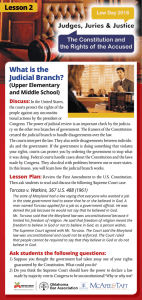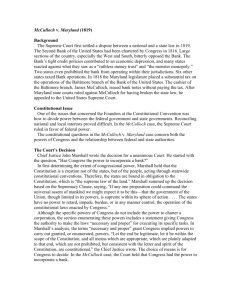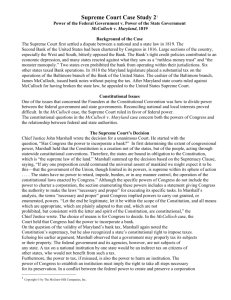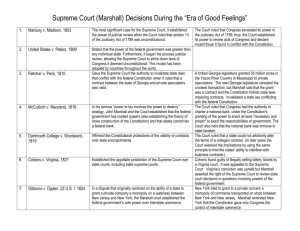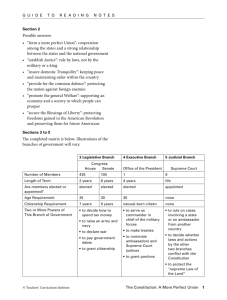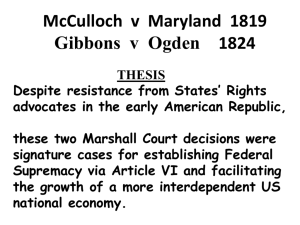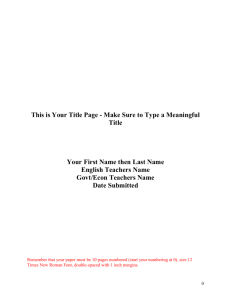National Supremacy (McCulloch v. Maryland)
advertisement
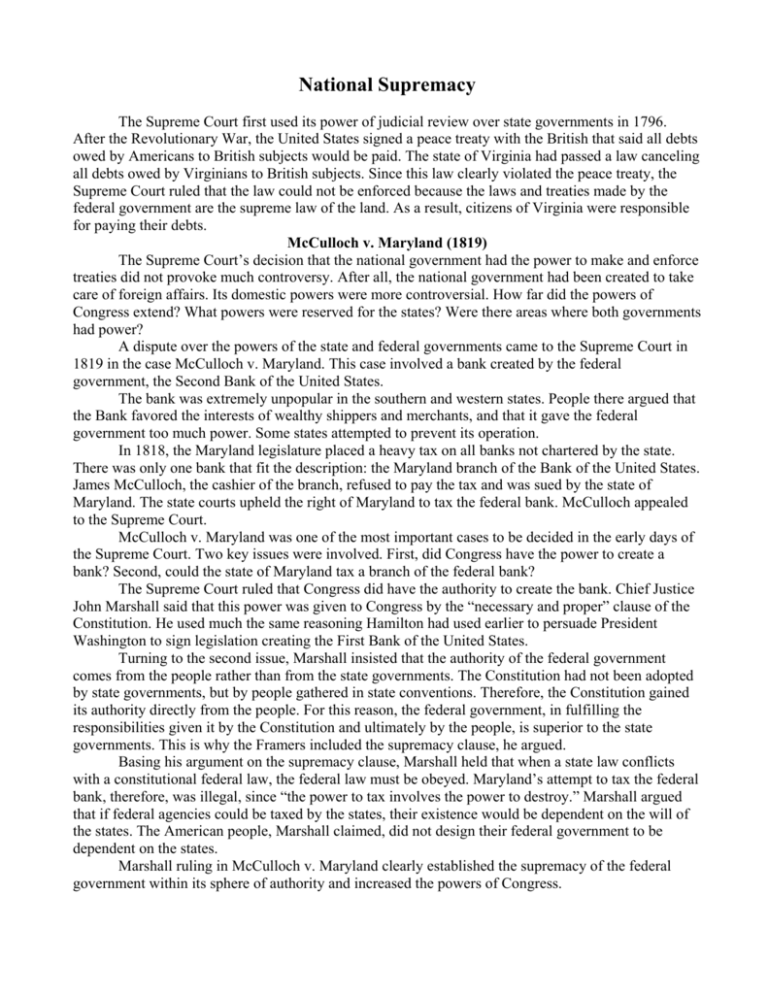
National Supremacy The Supreme Court first used its power of judicial review over state governments in 1796. After the Revolutionary War, the United States signed a peace treaty with the British that said all debts owed by Americans to British subjects would be paid. The state of Virginia had passed a law canceling all debts owed by Virginians to British subjects. Since this law clearly violated the peace treaty, the Supreme Court ruled that the law could not be enforced because the laws and treaties made by the federal government are the supreme law of the land. As a result, citizens of Virginia were responsible for paying their debts. McCulloch v. Maryland (1819) The Supreme Court’s decision that the national government had the power to make and enforce treaties did not provoke much controversy. After all, the national government had been created to take care of foreign affairs. Its domestic powers were more controversial. How far did the powers of Congress extend? What powers were reserved for the states? Were there areas where both governments had power? A dispute over the powers of the state and federal governments came to the Supreme Court in 1819 in the case McCulloch v. Maryland. This case involved a bank created by the federal government, the Second Bank of the United States. The bank was extremely unpopular in the southern and western states. People there argued that the Bank favored the interests of wealthy shippers and merchants, and that it gave the federal government too much power. Some states attempted to prevent its operation. In 1818, the Maryland legislature placed a heavy tax on all banks not chartered by the state. There was only one bank that fit the description: the Maryland branch of the Bank of the United States. James McCulloch, the cashier of the branch, refused to pay the tax and was sued by the state of Maryland. The state courts upheld the right of Maryland to tax the federal bank. McCulloch appealed to the Supreme Court. McCulloch v. Maryland was one of the most important cases to be decided in the early days of the Supreme Court. Two key issues were involved. First, did Congress have the power to create a bank? Second, could the state of Maryland tax a branch of the federal bank? The Supreme Court ruled that Congress did have the authority to create the bank. Chief Justice John Marshall said that this power was given to Congress by the “necessary and proper” clause of the Constitution. He used much the same reasoning Hamilton had used earlier to persuade President Washington to sign legislation creating the First Bank of the United States. Turning to the second issue, Marshall insisted that the authority of the federal government comes from the people rather than from the state governments. The Constitution had not been adopted by state governments, but by people gathered in state conventions. Therefore, the Constitution gained its authority directly from the people. For this reason, the federal government, in fulfilling the responsibilities given it by the Constitution and ultimately by the people, is superior to the state governments. This is why the Framers included the supremacy clause, he argued. Basing his argument on the supremacy clause, Marshall held that when a state law conflicts with a constitutional federal law, the federal law must be obeyed. Maryland’s attempt to tax the federal bank, therefore, was illegal, since “the power to tax involves the power to destroy.” Marshall argued that if federal agencies could be taxed by the states, their existence would be dependent on the will of the states. The American people, Marshall claimed, did not design their federal government to be dependent on the states. Marshall ruling in McCulloch v. Maryland clearly established the supremacy of the federal government within its sphere of authority and increased the powers of Congress. How has the Commerce power been used to expand federal authority? The Constitution gives Congress the power to “regulate Commerce…among the several states.” What is “commerce”? In 1824, the Supreme Court gave a very wide definition of commerce in the case of Gibbons v. Ogden. The dispute was about whether a federal license to operate steamboats between New York and New Jersey took precedence over a state license issued by New York. The Court ruled that “navigation” was part of commerce, so the federal license took precedence. In the late nineteenth century, the Supreme Court took a much more limited view of commerce. It also took a very limited view of “interstate.” As a result, the Court denied Congress the power to regulate such things as child labor in factories. The Court ruled that manufacturing was not part of commerce. It was also something that was done entirely within a single state. In a dramatic switch by the court in National Labor Relations Board v. Jones and Laughlin Steel Corp. (1937), the previous reading limiting the commerce definition was abandoned. As a result, Congress has been able to regulate such things as minimum wages and job safety. It also has been able to enact laws regulating things that seem far removed from “commerce.” For example, the Civil Rights Act of 1964 is partly based on the commerce power. The prohibitions against discrimination in employment and public accommodations are limited to employers and establishments affecting interstate commerce. What power does the federal government have today? Citizens demand more from the federal government today than they did in the past. In addition, the United States’ political and military role in the world has greatly increased. As a result, the federal government now has far more power than anything the Framers could have imagined. In come ways it can be argued that what the Anti-Federalists feared has indeed occurred-the federal government now has power over areas of people’s lives that used to be controlled by the states or by the people themselves. The power of the federal government is not limited, of course, to making laws. Indeed, it is increasingly common for the federal government to attempt to influence state law by the use of federal funds. For example, in the past the federal government used highway funds to encourage the states to set uniform speed limits. If a state did not agree to do this, it did not receive federal highway funds. Two hundred years ago, the Framers could not have predicted the relationship today between the power of the states and the power of the federal government. The complexities of the new system of political organization they created, as well as the realities governments confront, make it equally unlikely that we can predict with a high degree of accuracy the nature of the relationship in the future.
